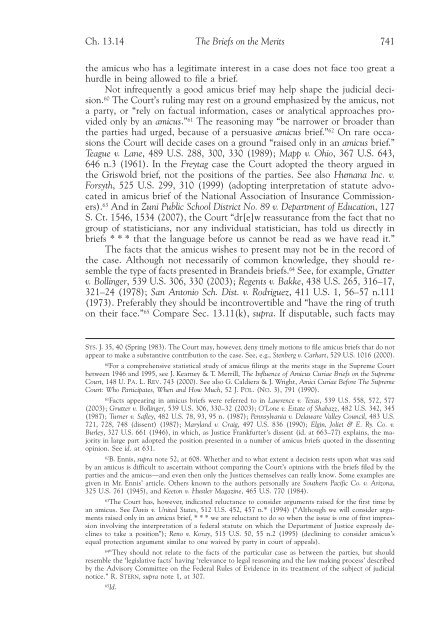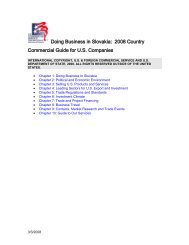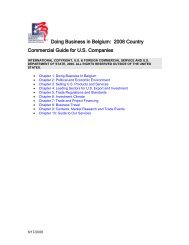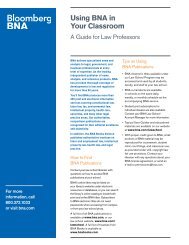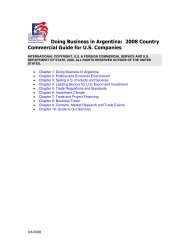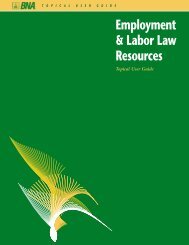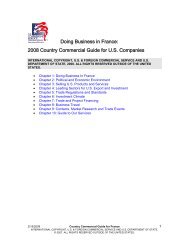You also want an ePaper? Increase the reach of your titles
YUMPU automatically turns print PDFs into web optimized ePapers that Google loves.
Ch. 13.14 <str<strong>on</strong>g>The</str<strong>on</strong>g> <str<strong>on</strong>g>Briefs</str<strong>on</strong>g> <strong>on</strong> <strong>the</strong> <strong>Merits</strong> 741<br />
<strong>the</strong> amicus who has a legitimate interest in a case does not face too great a<br />
hurdle in being allowed to file a brief.<br />
Not infrequently a good amicus brief may help shape <strong>the</strong> judicial decisi<strong>on</strong>.<br />
60 <str<strong>on</strong>g>The</str<strong>on</strong>g> Court’s ruling may rest <strong>on</strong> a ground emphasized by <strong>the</strong> amicus, not<br />
a party, or “rely <strong>on</strong> factual informati<strong>on</strong>, cases or analytical approaches provided<br />
<strong>on</strong>ly by an amicus.” 61 <str<strong>on</strong>g>The</str<strong>on</strong>g> reas<strong>on</strong>ing may “be narrower or broader than<br />
<strong>the</strong> parties had urged, because of a persuasive amicus brief.” 62 On rare occasi<strong>on</strong>s<br />
<strong>the</strong> Court will decide cases <strong>on</strong> a ground “raised <strong>on</strong>ly in an amicus brief.”<br />
Teague v. Lane, 489 U.S. 288, 300, 330 (1989); Mapp v. Ohio, 367 U.S. 643,<br />
646 n.3 (1961). In <strong>the</strong> Freytag case <strong>the</strong> Court adopted <strong>the</strong> <strong>the</strong>ory argued in<br />
<strong>the</strong> Griswold brief, not <strong>the</strong> positi<strong>on</strong>s of <strong>the</strong> parties. See also Humana Inc. v.<br />
Forsyth, 525 U.S. 299, 310 (1999) (adopting interpretati<strong>on</strong> of statute advocated<br />
in amicus brief of <strong>the</strong> Nati<strong>on</strong>al Associati<strong>on</strong> of Insurance Commissi<strong>on</strong>ers).<br />
63 And in Zuni Public School District No. 89 v. Department of Educati<strong>on</strong>, 127<br />
S. Ct. 1546, 1534 (2007), <strong>the</strong> Court “dr[e]w reassurance from <strong>the</strong> fact that no<br />
group of statisticians, nor any individual statistician, has told us directly in<br />
briefs * * * that <strong>the</strong> language before us cannot be read as we have read it.”<br />
<str<strong>on</strong>g>The</str<strong>on</strong>g> facts that <strong>the</strong> amicus wishes to present may not be in <strong>the</strong> record of<br />
<strong>the</strong> case. Although not necessarily of comm<strong>on</strong> knowledge, <strong>the</strong>y should resemble<br />
<strong>the</strong> type of facts presented in Brandeis briefs. 64 See, for example, Grutter<br />
v. Bollinger, 539 U.S. 306, 330 (2003); Regents v. Bakke, 438 U.S. 265, 316–17,<br />
321–24 (1978); San Ant<strong>on</strong>io Sch. Dist. v. Rodriguez, 411 U.S. 1, 56–57 n.111<br />
(1973). Preferably <strong>the</strong>y should be inc<strong>on</strong>trovertible and “have <strong>the</strong> ring of truth<br />
<strong>on</strong> <strong>the</strong>ir face.” 65 Compare Sec. 13.11(k), supra. If disputable, such facts may<br />
SYS. J. 35, 40 (Spring 1983). <str<strong>on</strong>g>The</str<strong>on</strong>g> Court may, however, deny timely moti<strong>on</strong>s to file amicus briefs that do not<br />
appear to make a substantive c<strong>on</strong>tributi<strong>on</strong> to <strong>the</strong> case. See, e.g., Stenberg v. Carhart, 529 U.S. 1016 (2000).<br />
60 For a comprehensive statistical study of amicus filings at <strong>the</strong> merits stage in <strong>the</strong> Supreme Court<br />
between 1946 and 1995, see J. Kearney & T. Merrill, <str<strong>on</strong>g>The</str<strong>on</strong>g> Influence of Amicus Curiae <str<strong>on</strong>g>Briefs</str<strong>on</strong>g> <strong>on</strong> <strong>the</strong> Supreme<br />
Court, 148 U. PA. L. REV. 743 (2000). See also G. Caldiera & J. Wright, Amici Curiae Before <str<strong>on</strong>g>The</str<strong>on</strong>g> Supreme<br />
Court: Who Participates, When and How Much, 52 J. POL. (NO. 3), 791 (1990).<br />
61 Facts appearing in amicus briefs were referred to in Lawrence v. Texas, 539 U.S. 558, 572, 577<br />
(2003); Grutter v. Bollinger, 539 U.S. 306, 330–32 (2003); O’L<strong>on</strong>e v. Estate of Shabazz, 482 U.S. 342, 345<br />
(1987); Turner v. Safley, 482 U.S. 78, 93, 95 n. (1987); Pennsylvania v. Delaware Valley Council, 483 U.S.<br />
721, 728, 748 (dissent) (1987); Maryland v. Craig, 497 U.S. 836 (1990); Elgin, Joliet & E. Ry. Co. v.<br />
Burley, 327 U.S. 661 (1946), in which, as Justice Frankfurter’s dissent (id. at 663–77) explains, <strong>the</strong> majority<br />
in large part adopted <strong>the</strong> positi<strong>on</strong> presented in a number of amicus briefs quoted in <strong>the</strong> dissenting<br />
opini<strong>on</strong>. See id. at 631.<br />
62 B. Ennis, supra note 52, at 608. Whe<strong>the</strong>r and to what extent a decisi<strong>on</strong> rests up<strong>on</strong> what was said<br />
by an amicus is difficult to ascertain without comparing <strong>the</strong> Court’s opini<strong>on</strong>s with <strong>the</strong> briefs filed by <strong>the</strong><br />
parties and <strong>the</strong> amicus—and even <strong>the</strong>n <strong>on</strong>ly <strong>the</strong> Justices <strong>the</strong>mselves can really know. Some examples are<br />
given in Mr. Ennis’ article. O<strong>the</strong>rs known to <strong>the</strong> authors pers<strong>on</strong>ally are Sou<strong>the</strong>rn Pacific Co. v. Ariz<strong>on</strong>a,<br />
325 U.S. 761 (1945), and Keet<strong>on</strong> v. Hustler Magazine, 465 U.S. 770 (1984).<br />
63<str<strong>on</strong>g>The</str<strong>on</strong>g> Court has, however, indicated reluctance to c<strong>on</strong>sider arguments raised for <strong>the</strong> first time by<br />
an amicus. See Davis v. United States, 512 U.S. 452, 457 n.* (1994) (“Although we will c<strong>on</strong>sider arguments<br />
raised <strong>on</strong>ly in an amicus brief, * * * we are reluctant to do so when <strong>the</strong> issue is <strong>on</strong>e of first impressi<strong>on</strong><br />
involving <strong>the</strong> interpretati<strong>on</strong> of a federal statute <strong>on</strong> which <strong>the</strong> Department of Justice expressly declines<br />
to take a positi<strong>on</strong>”); Reno v. Koray, 515 U.S. 50, 55 n.2 (1995) (declining to c<strong>on</strong>sider amicus’s<br />
equal protecti<strong>on</strong> argument similar to <strong>on</strong>e waived by party in court of appeals).<br />
64 “<str<strong>on</strong>g>The</str<strong>on</strong>g>y should not relate to <strong>the</strong> facts of <strong>the</strong> particular case as between <strong>the</strong> parties, but should<br />
resemble <strong>the</strong> ‘legislative facts’ having ‘relevance to legal reas<strong>on</strong>ing and <strong>the</strong> law making process’ described<br />
by <strong>the</strong> Advisory Committee <strong>on</strong> <strong>the</strong> Federal Rules of Evidence in its treatment of <strong>the</strong> subject of judicial<br />
notice.” R. STERN, supra note 1, at 307.<br />
65 Id.


